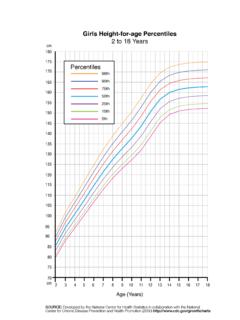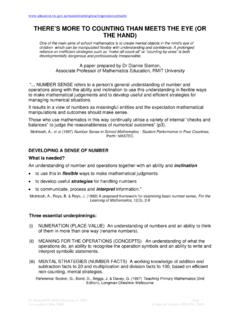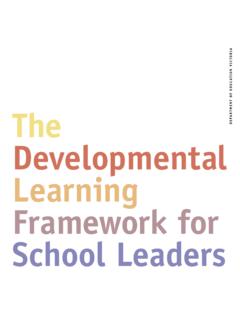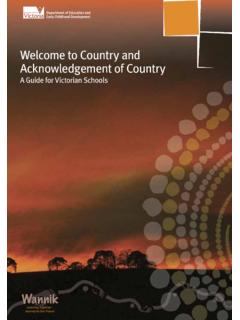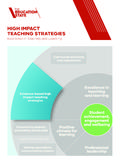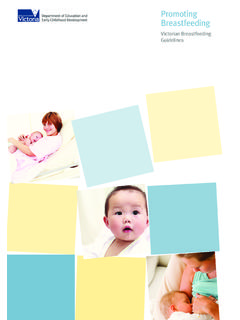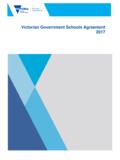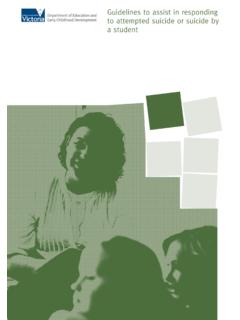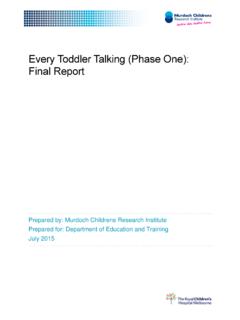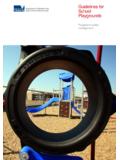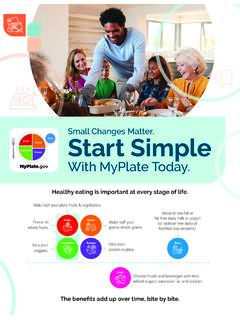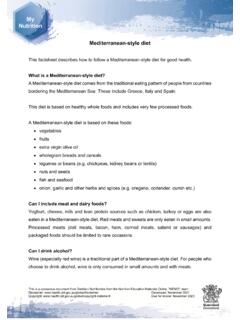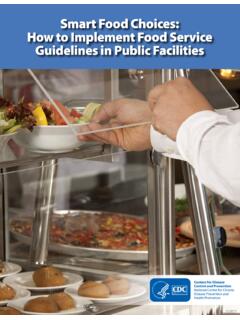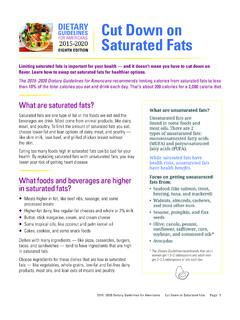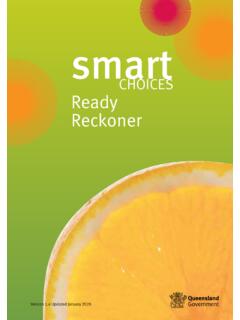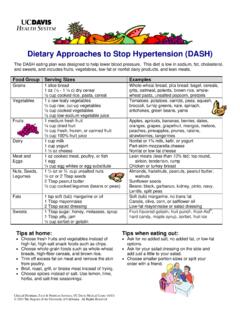Transcription of Food categories - Department of Education and Training
1 Food categoriesFoods and drinks have been classified into the following three categories according to their nutritional value. To promote healthy eating, schools should provide foods and drinks according to these categories :Everyday (green) foodsSelect Carefully (amber) foodsOccasionally (red) are also some foods and drinks that have been identified as not suitable to be supplied through school food services. From 2007, high sugar content soft drinks should not be supplied through school food services. This includes energy drinks and flavoured mineral waters with high sugar is of minimal nutritional value and high in kilojoules. For this reason the sale of confectionery through school food services will be phased out from 2007 2009. From 2009, no confectionery should be supplied through school food services. I Healthy Canteen Kit Food PlannerHealthy Canteen Kit Food Planner I everydayThe three food categorieseverydayselect careFoods and drinks in the Select Carefully category contain some valuable nutrients, but may also include unhealthy should:4 not let these foods and drinks dominate the canteen menu4 serve in smaller sizes4 limit selling and drinks in the Occasionally category are not recommended for school food foods and drinks:4 should not be on the regular canteen menu4 should be supplied on no more than two occasions per term4 should not be regularly available in other areas of the school such as vending CarefullyoccasionallyFoods and drinks in the Everyday category are most suitable for school food should.
2 4 encourage and promote these foods4 provide a wide range of these foods every day4 include as the main choices on the canteen menu4 promote these foods as tasty, fresh and good value choices4 present these foods in attractive and interesting ways4 include as the main choices at school events and activities involving food. I Healthy Canteen Kit Food PlannerEveryday category (green foods)Foods and drinks from the Everyday category are consistent with the Dietary Guidelines for Children and Adolescents in Australia and are most suitable for school food services. Providing a wide range of these healthy foods is important for variety. Foods and drinks in this category should be promoted as tasty, fresh and good value choices. These foods should be included as part of the canteen menu wherever possible. Foods and drinks in the Everyday category are based on the basic food groups and include:breads and cereals, rice, pasta, noodles vegetablesfruitsdairy foods reduced or low-fat milk, yoghurt and cheeselean meat and poultry, fish, eggs, nuts* and legumes (dried beans and lentils) foods and drinks are the best choices because they:are often high in nutrients and fibreare low in saturated fat and/or added sugars and/or salthelp to avoid an excess kilojoule this category even healthier choices can be made.
3 Wholegrain breads and cereal products are higher in fibre, for example grainy bread, high-fibre breakfast cereals, air-popped popcorn. Refer to the food guide tables on pages 16 24 for more information on foods and drinks in this is also an important part of the Everyday category.*Food allergies are the most common triggers for anaphylaxis (severe allergic reaction) in children. Eight foods cause 90 per cent of food allergies: peanuts, cow s milk, egg, wheat, soybean, tree nuts (for example, cashew), fish and shellfish. Schools should be aware of the risk of hidden allergens. Check your school s policy regarding students with severe allergies. Checklist for EVERYDAY foods4 Include most often as the main choices on the canteen available every day the canteen is open. 4 Strongly encourage and promote these foods and as the main choices at school events and activities involving food and Canteen Kit Food Planner I Select Carefully category (amber foods)Not all foods and drinks sit in the Everyday or Occasionally categories .
4 In between are a range of foods and drinks that contain some valuable nutrients but may also have some unhealthy ingredients. These foods are included in the Select Carefully of foods and drinks in this category include:full-fat dairy foods milk, yoghurt and cheeseprocessed meatscommercially prepared hot foodsmargarines, oils, spreads, sauces and graviessnack food bars (for example, breakfast bars, cereal bars, fruit bars)cakes, muffins, sweet biscuits, slicessavoury snack foods and biscuitslow or reduced-fat ice-creams, milk-based ice confections and dairy dessertsice blocks and ice slushees based on 100 per cent fruit juicedrinks 100 per cent fruit juices, some moderate-kilojoule sports watersartificially sweetened drinkssome breakfast cereals (with added sugar and/or saturated fat and low fibre).Foods and drinks on canteen-registered product buyer guides generally fall into the Select Carefully category.
5 These foods should be selected carefully because they:are moderate in added fat and/or sugar and/or salt contribute to excess kilojoules if consumed in large serve some nutritional to the food guide tables on pages 16 24 for more information on foods and drinks in the Select Carefully category. Note: Some of the food types listed above may fit into either the Select Carefully category or the Occasionally category. Read the labels and assess against the nutrient criteria for Occasionally foods. (Refer to page 13). 10 I Healthy Canteen Kit Food PlannerTo help avoid large serve sizes:consider appropriate serve sizes for primary and secondary students have mini options and half-serves for lower primary-aged students limit juice and flavoured milk serves (refer to the food guide tables on pages 16 24)take serve sizes into consideration when packing, preparing and serving foodsNote: many food companies are now starting to offer child-appropriate serve sizes.
6 Checklist for SELECT CAREFULLY foods4Do not let these foods and drinks dominate the large serve sizes. 4 Reduce the number of these foods on the canteen these foods only on certain days of the week or limit selling healthier choices within this choices of these foods that contain fruits and/or vegetables or serve with fruits and/or not promote vigorously at the expense of foods and drinks from the Everyday dietary requirementsSome students require special diets for medical reasons. The school principal, child s teacher or parents should provide advice of any special dietary needs to canteen staff. Medical conditions that have special dietary requirements include: diabetes coeliac disease (severe) food allergyContact with certain foods can be fatal for people with allergies to these foods. The most common triggers of anaphylaxis are: peanuts, cow s milk, egg, wheat, soy, tree nuts (for example, cashews), fish and shellfish.
7 The Department of Education & Training has guidelines for schools to support students with anaphylaxis. For more information, go to: and strict avoidance of nuts and nut products is extremely important for anyone with an anaphylactic nut allergy. Canteen staff need to be well aware of students with such allergies and familiar with the school s management strategies for these students. For detailed information on special dietary requirements refer to Go for your life Healthy Canteen Kit Canteen Manual, page Canteen Kit Food Planner I 11 Occasionally category (red foods)Foods and drinks in this category are not consistent with the Dietary Guidelines for Children and Adolescents in Australia and are not suitable for school food and drinks in this category are based on the extra foods as defined in the Australian Guide to Healthy Eating and include.
8 Sugar-sweetened drinks sports drinks, cordial, fruit-flavoured drinks deep-fried foodspastry-based or crumbed hot foodssavoury snack foods crisps, chips, biscuits and other similar productsice-creams, ice confections and dairy desserts, for example chocolate-coated and premium ice-creams, icy-polescakes, muffins, sweet biscuits, slices, bars, donuts, danishes, croissants cream, butter, copha and chocolate foods and drinks are the least suitable as, generally, they:are very low in nutritional valueare high in saturated fat and/or added sugar and/or added salt provide excess and drinks which fit into the occasionally (red foods) category should be supplied on no more than two occasions per term. There are many foods and drinks that may fall into either the Occasionally category or the Select Carefully category.
9 Read the labels and assess against the nutrient criteria for an Occasionally food. The food guide tables on pages 16 24 provide more information on the types of foods that fall into the Occasionally 2007, high sugar content soft drinks should not be supplied through school food services. This includes energy drinks and flavoured mineral waters with high sugar is of minimal nutritional value and high in kilojoules. For this reason the sale of confectionery through school food services will be phased out from 2007 2009, no confectionery should be supplied through school food services. Checklist for OCCASIONALLY foods4 These foods and drinks should not be on the regular canteen menu4 Limit the availability of these foods and drinks to no more than two occasions per foods and drinks should not be regularly available in other areas of the school such as in vending machines.
10 1 I Healthy Canteen Kit Food PlannerHow to identify foods and drinks in the Occasionally categoryThe following tables list a set of nutrient criteria* for certain types of foods and drinks that may fall under the Occasionally nutrient criteria tables are a useful tool to determine if a particular food fits into either the Select Carefully category or Occasionally are nutrient criteria for two types of food groupings: hot food itemssnack foods and food types are the most likely to fit into the Occasionally category. Food types such as fruit and vegetables do not require assessing against nutrient criteria as these foods are usually in the Everyday nutrient criteria have been developed specific to each food category s that:total fat and sugar have not been included within the nutrient criteria.
